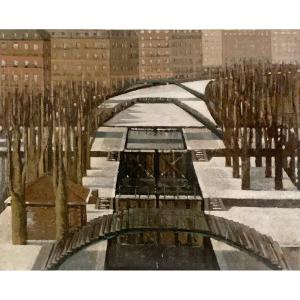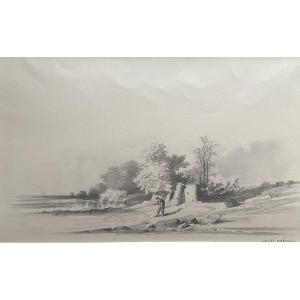Landscape
Pencil and stump on paper
Stamp of the studio sale on the back
46 x 28 cm
frame: 65 x 46 cm
Provenance: artist's studio sale, Paris, Hôtel Drouot, December 1987, Mr. Chambellad, Giafferi and Veyrac.
Famous tablet maker of the early 20th century, Eugénie O'kin was born in Yokohama (Japan) in 1880 to a Japanese mother and a French father. She later adopted the name “O'kin” which evokes the exoticism of her country of origin. In a context of Japan opening up to the world, Eugénie O'kin developed an interest in the arts and first devoted herself to drawing. She diverts patterns present on fabrics, prints or even ceramics. The influence of his non-European roots shines through in all his artistic production, described as “modernist”.
She met her husband Henri Simmen (1880-1963) while he was traveling in Japan and then settled in Paris around 1900. Introduced to the art of tabletmaking, the young artist sculpted small objects (buttons, combs, boxes, game pieces etc.) in precious materials such as ivory, horn or even ebony. She exhibited her work for the first time in 1907 at the Salon d'Automne, the Salon de la société nationale des beaux-arts and the Salon des artistes français. It met with great success. In 1910, the Museum of Decorative Arts in Paris bought him a bowl in engraved horn, pearl and silver.
The couple, with their distinct skills, regularly collaborated on the creation of pieces that marked the decorative arts of the early 20th century. Eugénie O'kin creates the lids, sockets and even sculpted ivory or ebony bases which adorn Henri Simmen's ceramics. The decorator Jacques-Emile Ruhlmann also called on her in the 1920s. He notably presented her work in his famous Hôtel du Collector erected for the International Exhibition of Modern Decorative and Industrial Arts of 1925.
We find in Eugénie's drawings O'kin the stylization of the shapes specific to his sculpted objects. His research thus seems to complement each other with finesse and delicacy. The gradient that appears in the refined landscape that we present seems to break down the volume of organic shapes with fluid lines, which is reminiscent of Japanese drawing.

























 Le Magazine de PROANTIC
Le Magazine de PROANTIC TRÉSORS Magazine
TRÉSORS Magazine Rivista Artiquariato
Rivista Artiquariato
